Cheng’s Commune represents the village’s 1,000 inhabitants. Gender mainstreaming has yet to hit this part of the world, and Cheng, as the sole representative of her sex, is assigned by the men on the Council to work on women and children’s issues, particularly health education. She speaks slowly, in pace with the rhythm of the day unfolding in her yard; half-dressed children shooting marbles and staring at the visiting barang (white person) (2), men folding pond lilies to sell at the market, and a variety of chickens and pigs rooting in the dirt for food.
There have been trainings available to her in the last several years to ‘build her capacity’ as a Councilor. Non-governmental organizations (NGOs) have held trainings in the provincial capital on conflict mediation, domestic violence, and gender issues for selected Commune Councilors. However, many obstacles exist to Cheng carrying out her duties. When asked about the protocol for handling domestic disputes in the community, Cheng shrugs and says she sends it up to the next level in the government hierarchy. She mentions the difficulties in mobilizing women in the village because they are busy and expect to receive a gift if they attend a meeting, a legacy of the political patronage rampant in
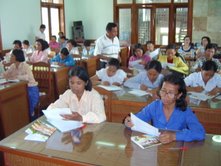 Cheng’s mother listens to our discussion from a hammock strung up underneath the house. Although her daughter has been a Councilor for over four years, she doesn’t know what the Council does and has never been to one of their meetings. Her resignation is typical of her generation; the elders have had their dreams suppressed by decades of civil war and occupation. Yet her apathy undercuts the predicted participatory democracy enthusiasm hoped for by decentralization advocates. It also illuminates a serious need in Cambodian society to promote national reconciliation between former victims, perpetrators and alienated community members through dynamic, grassroots peacebuilding initiatives.
Cheng’s mother listens to our discussion from a hammock strung up underneath the house. Although her daughter has been a Councilor for over four years, she doesn’t know what the Council does and has never been to one of their meetings. Her resignation is typical of her generation; the elders have had their dreams suppressed by decades of civil war and occupation. Yet her apathy undercuts the predicted participatory democracy enthusiasm hoped for by decentralization advocates. It also illuminates a serious need in Cambodian society to promote national reconciliation between former victims, perpetrators and alienated community members through dynamic, grassroots peacebuilding initiatives.
The NGO Ghetto: Development as the New Colonialism?
Students and interns like us with summer months free to put their theoretical training to the test show up at the Khmer Institute of Democracy (KID) and are launched into the unique underworld of domestic and international NGO politics. The area just south of Sihanouk Blvd (named after the King Father) is known unofficially as ‘NGO Alley.’ There are so many NGOs and international funding organizations in these few square blocks that one wonders flippantly for a moment why more problems have not been solved with this much aid pouring in. As of 1998, a staggering 14 percent of
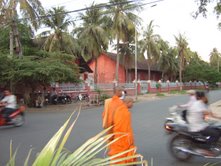 In some ways, the large number of non-Cambodians living in
In some ways, the large number of non-Cambodians living in
The parallels between development and colonialism are striking. Upon visiting Phnom Penh, a first generation Indian-American man said that the city reminded him of colonial India where "the haves had white skin and the have-nots had brown skin only in Phnom Penh, the white-skinned people are development workers." Perhaps we should not be too surprised by this fact, as development has its ideological roots in colonialism. But as white middle class do-gooders seeking to make an ethically orchestrated impact in the world, the implications of our very presence here sometimes make us queasy.
 Our hope is that the projects we are working on justify the negative elements of being a foreigner here. KID juggles a handful of programs ranging from training newly elected local government officials in democracy, law, and conflict resolution to educating the Cambodian public about the upcoming trial of former Khmer Rouge officials. The organization was established in 1992, making it a veteran organization in a land of recently developed infrastructure and civil society.
Our hope is that the projects we are working on justify the negative elements of being a foreigner here. KID juggles a handful of programs ranging from training newly elected local government officials in democracy, law, and conflict resolution to educating the Cambodian public about the upcoming trial of former Khmer Rouge officials. The organization was established in 1992, making it a veteran organization in a land of recently developed infrastructure and civil society.
Struggling Civil Society is a Legacy of War
Why, you might be asking at this point, is there so little infrastructure in a culture boasting some of the most advanced ancient art in the world? Particularly if you weren’t old enough to be grazing the international news in the 1970’s, you may not have heard much about the communist Khmer Rouge regime which dominates
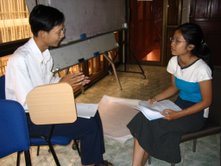 Within days of taking control of the country, the Khmer Rouge regime evacuated city dwellers and put them to work in forced rural labor camps which were gender and age segregated. All schools, government, health care and religious systems were made illegal. Civil servants and other educated people were summarily rounded up and executed on the spot for being bourgeoisie and thus sympathetic to the American imperialists. People wearing glasses were targeted under the assumption that they were well educated. For 3 years, 8 months, and 20 days, from 1975-1979, the Khmer Rouge obliterated the cultural and physical infrastructure of Cambodia, killing nearly two million of the nation’s 8 million inhabitants and leaving a legacy of trauma that haunts the country to this day. Cambodians prefer to repeat the words “3 years, 8 months, and 20 days” instead of referring to the words “Khmer Rouge” or its leader “Pol Pot.” This length of time has gained meaning in a way that we have never before encountered – a negative nostalgia.
Within days of taking control of the country, the Khmer Rouge regime evacuated city dwellers and put them to work in forced rural labor camps which were gender and age segregated. All schools, government, health care and religious systems were made illegal. Civil servants and other educated people were summarily rounded up and executed on the spot for being bourgeoisie and thus sympathetic to the American imperialists. People wearing glasses were targeted under the assumption that they were well educated. For 3 years, 8 months, and 20 days, from 1975-1979, the Khmer Rouge obliterated the cultural and physical infrastructure of Cambodia, killing nearly two million of the nation’s 8 million inhabitants and leaving a legacy of trauma that haunts the country to this day. Cambodians prefer to repeat the words “3 years, 8 months, and 20 days” instead of referring to the words “Khmer Rouge” or its leader “Pol Pot.” This length of time has gained meaning in a way that we have never before encountered – a negative nostalgia.
The Vietnamese military ‘liberated’ the Cambodian populace from the grips of the Khmer Rouge in 1979, and subsequently occupied the country for a decade. Tension persists today between Cambodians and Vietnamese because of the complexity of liberation and occupation and often plays out as mutual racism. It was not until
To be Young, Cambodian and Educated
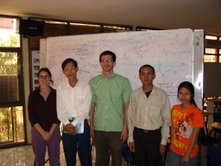 Nearly 35% of Cambodians are under the age of 15, and the median age is 20 (4). Many young people do not believe their parents’ stories about the Khmer Rouge (see our previous article in Toward Freedom on this subject). Yet an increasing number of young people graduate from a burgeoning number of mostly private universities throughout the country. The jobs most sought-after by these graduates are in the NGO sector, as they are relatively high-paying and prestigious – the inverse of the perception of non-profit jobs in the
Nearly 35% of Cambodians are under the age of 15, and the median age is 20 (4). Many young people do not believe their parents’ stories about the Khmer Rouge (see our previous article in Toward Freedom on this subject). Yet an increasing number of young people graduate from a burgeoning number of mostly private universities throughout the country. The jobs most sought-after by these graduates are in the NGO sector, as they are relatively high-paying and prestigious – the inverse of the perception of non-profit jobs in the
We have sat with truly inspiring people working at KID and other NGOs, who are asking real questions about how to effectively serve fellow Cambodians. From conflict resolution training to film production to poverty reduction, young Cambodians dedicated to social change are expressing their visions through their work. In contrast to the unrestrained idealism of many activists in the
In some sense, this pragmatism is quite radical. In the
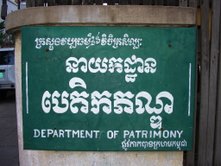 Yet Cambodian NGOs struggle to live up to the positive language of their mission statements for a variety of reasons. Lack of organizational and human capacity, cultural trends of strict hierarchy and the desire for status, donor-driven agendas, and a nascent civil society all contribute to NGO dysfunction. While these obstacles can seem insurmountable, women like Chher Cheng – the female Commune Councilor at the beginning of our story – offer hope to us. She is choosing to get involved with local politics and participates persistently in what has traditionally been a man’s world. As NGOs like KID improve their ability to implement truly empowering trainings for citizens, women such as Cheng will grow more confident in their abilities as leaders. They can pass knowledge to their neighbors and daughters to fuel the next generation of Cambodians dedicated to social change, Cambodian-style.
Yet Cambodian NGOs struggle to live up to the positive language of their mission statements for a variety of reasons. Lack of organizational and human capacity, cultural trends of strict hierarchy and the desire for status, donor-driven agendas, and a nascent civil society all contribute to NGO dysfunction. While these obstacles can seem insurmountable, women like Chher Cheng – the female Commune Councilor at the beginning of our story – offer hope to us. She is choosing to get involved with local politics and participates persistently in what has traditionally been a man’s world. As NGOs like KID improve their ability to implement truly empowering trainings for citizens, women such as Cheng will grow more confident in their abilities as leaders. They can pass knowledge to their neighbors and daughters to fuel the next generation of Cambodians dedicated to social change, Cambodian-style.
Notes:
(1) Chher Cheng is not her real name
(2) Literally means ‘French,’ a hangover from colonialism, but now used loosely for all white foreigners
(3) Godfrey et al 1998 cited in – Curly, Melissa. 2004. The Role of the Non-Profit Sector in Transitional Asian Economies:
(4) CIA World
Mneesha Gellman and Josh Dankoff are interns at the Khmer Institute of Democracy in Phnom Penh,
